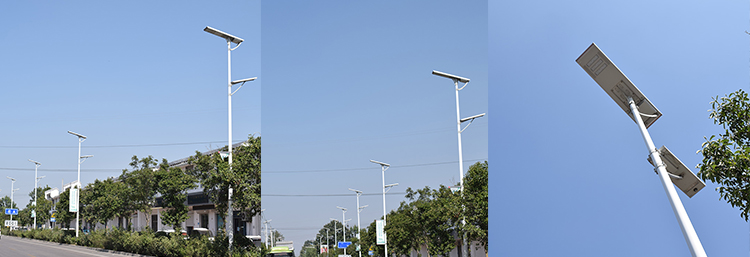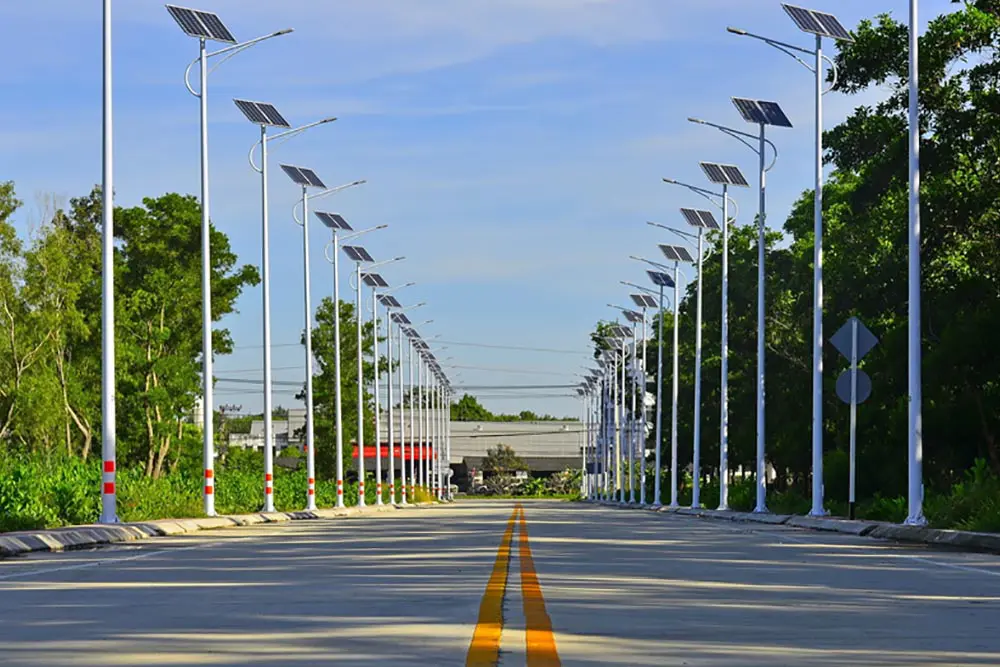In recent years, solar street lights have emerged as a sustainable and energy-efficient alternative to traditional street lighting systems.
Powered by the sun’s abundant and renewable energy, these innovative lighting solutions are gaining popularity worldwide.
Solar street-lights offer numerous advantages, including reduced energy consumption, cost savings, environmental friendliness, and improved safety.
This article explores the features, benefits, and functionality of solar street lights, shedding light on their transformative potential for urban and rural areas alike.
How Solar Street Lights Work

Solar street lights operate through the conversion of sunlight into electricity using photovoltaic (PV) cells.
These cells, typically composed of silicon, absorb sunlight and generate direct current (DC) electrical energy.
An attached controller regulates the charging and discharging of the battery, ensuring optimal performance.
As the sun sets, the stored energy is released to power the LED (Light Emitting Diode) lamps, providing illumination throughout the night.
Key Features of Solar Street Lights

a. PV Panels:
The solar panels are installed on top of the street light, absorbing sunlight and converting it into electricity. These panels are designed to maximize energy conversion efficiency.
b. Battery:
The battery is an essential component that stores the excess solar energy during the day to power the street light at night. Typically, deep cycle batteries with high energy density are used to ensure reliable operation.
c. LED Lamps:
Light Emitting Diodes (LEDs) are highly energy-efficient and long-lasting. These lamps provide bright illumination while consuming minimal power, ensuring extended operation periods.
d. Controller:
The controller plays a crucial role in regulating the charging and discharging of the battery. It also manages the on/off cycles of the LED lamps, ensuring optimal performance and preventing overcharging or discharging.
e. Sensors and Dimming Options:
Solar street-lights often come equipped with intelligent sensors, such as motion detectors or ambient light sensors.
These sensors enable the lights to automatically adjust their brightness based on the surrounding conditions, further optimizing energy usage.
Advantages of Solar Street Lights

Solar street lights offer a wide range of advantages compared to traditional grid-powered lighting systems
a. Energy Efficiency:
Solar street lights are powered by clean and renewable solar energy, reducing reliance on conventional electricity sources. This significantly lowers energy consumption and associated costs.
b. Cost Savings:
While the upfront investment for solar street lights may be higher than traditional lighting systems, the long-term cost savings are substantial.
Solar street lights eliminate electricity bills and require minimal maintenance, resulting in reduced operational costs.
c. Environmental Friendliness:
Solar street-lights have a minimal carbon footprint compared to conventional lighting systems.
By utilizing clean energy, they contribute to reducing greenhouse gas emissions and combatting climate change.
d. Easy Installation and Maintenance:
Solar street-lights are relatively easy to install, as they do not require extensive wiring or connection to the electrical grid.
Additionally, maintenance requirements are minimal, with no need for regular bulb replacements.
e. Enhanced Safety:
Properly illuminated streets enhance safety for pedestrians, cyclists, and drivers, reducing the risk of accidents and improving overall security in urban and rural areas.
Solar street lights provide consistent lighting throughout the night, ensuring visibility in areas that might otherwise be poorly lit.
f. Versatility:
Solar street-lights can be installed in remote or off-grid locations where access to electricity is limited or non-existent.
They offer a versatile lighting solution for various applications, including residential areas, parking lots, parks, pathways, and highways.
g. Easy Installation and Maintenance:
Solar street-lights are relatively easy to install since they do not require extensive electrical work or underground wiring.
Additionally, they have fewer components, reducing the need for regular maintenance.
h. Renewable and Sustainable:
Solar street lights rely on the abundant and renewable energy of the sun, reducing dependence on fossil fuels and mitigating greenhouse gas emissions.
Applications of Solar Street Lighting

Solar street lighting has a wide range of applications and can be implemented in various settings.
Here are some common applications of solar street lighting
1. Urban Streets and Roads:
Solar street lights are commonly used for illuminating urban streets and roads, providing visibility and safety for pedestrians, cyclists, and motorists.
They can replace traditional grid-based street lights, reducing energy consumption and carbon emissions.
2. Residential Areas:
Solar streetlights are ideal for lighting up residential neighborhoods and housing complexes.
They can enhance the security and ambiance of the area while reducing electricity costs for homeowners and community associations.
3. Parks and Recreational Areas:
Solar streetlights are often used to illuminate parks, jogging tracks, playgrounds, and other recreational areas. They create a safe and inviting environment for outdoor activities during the evening hours.
4. Parking Lots and Carports:
Solar street lights can be installed in parking lots and carports to provide lighting for vehicles and pedestrians.
They enhance visibility and security in these areas while reducing the reliance on grid electricity.
5. Pathways and Walkways:
Solar streetlights are commonly used to light up pathways, walkways, and sidewalks in public spaces such as universities, hospitals, shopping centers, and public parks.
They improve safety for pedestrians and help guide them during the dark hours.
6. Rural and Remote Areas:
Solar street lights are particularly beneficial in rural and remote areas that lack access to reliable electricity grids.
They provide lighting for community centers, schools, healthcare facilities, and village streets, improving overall living conditions and safety.
7. Construction Sites and Temporary Lighting Needs:
Solar street lights are portable and can be used as temporary lighting solutions for construction sites, events, festivals, and emergency situations.
They eliminate the need for temporary electrical connections and provide immediate lighting without additional infrastructure.
8. Military and Defense Installations:
Solar street lights are deployed in military bases, defense installations, and border areas to ensure proper lighting and security.
They offer independence from grid electricity, reducing vulnerability and ensuring uninterrupted lighting in critical areas.
9. Off-Grid and Developing Areas:
Solar street-lights are extensively used in off-grid areas and developing regions with limited access to electricity.
They serve as a sustainable and reliable lighting solution, contributing to education, healthcare, and overall development in these communities.
10. Smart City Integration:
Solar street lights can be integrated into smart city initiatives, incorporating features such as motion sensors, remote monitoring, and dimming controls.
These advanced functionalities optimize energy usage, improve maintenance efficiency, and enhance overall urban management.
In summary, solar street lighting finds application in a diverse range of settings, including urban areas, residential neighborhoods, parks, parking lots, pathways, rural communities, and temporary lighting needs.
Its versatility, sustainability, and cost-effectiveness make it a viable choice for illuminating various public and private spaces.
11. Roadways and Highways:
Solar street lights are extensively used for lighting up roadways and highways, providing enhanced visibility and safety for motorists and pedestrians.
They ensure well-lit streets at nighttime, reducing the risk of accidents and improving overall road safety.
12. Public Spaces:
Solar street lights are widely deployed in public spaces such as parks, gardens, plazas, and promenades.
They create well-lit and inviting environments for recreational activities, enhancing public safety and security during evening hours.
13. Industrial and Commercial Areas:
Solar street lights are suitable for lighting industrial and commercial areas, including warehouses, factories, construction sites, and commercial complexes.
They offer efficient and reliable lighting solutions, even in remote or off-grid locations, contributing to a safe and productive work environment.
Potential Impact on Urban Landscapes
Solar street lights have the potential to transform the aesthetic and functionality of urban landscapes.
By utilizing solar-powered lighting, cities can enhance their sustainability credentials and contribute to a cleaner environment.
Solar street lights can be seamlessly integrated into existing infrastructure, providing uniform lighting in public spaces, residential areas, parks, and parking lots.
The absence of unsightly power cables and the flexibility of installation make them a versatile solution that can be tailored to suit the unique requirements of different urban settings.
Challenges and Future Outlook
While solar street lights offer numerous benefits, a few challenges remain. The initial investment cost and the limited energy storage capacity of batteries are areas that require further improvement.
However, advancements in technology and decreasing costs of solar panels and batteries are addressing these challenges, making solar street lights a more viable option.
The future of solar street lights looks promising. Ongoing research aims to enhance the efficiency of solar panels, develop advanced battery technologies, and improve overall system performance.
Governments, municipalities, and organizations are increasingly embracing solar street lights as a sustainable lighting solution, further driving innovation and adoption.
Frequently Asked Questions
How Do Solar Street Lights Work?
Solar street lights work by harnessing sunlight through solar panels, which convert it into electricity. This electricity is stored in batteries and used to power LED lights during nighttime or when there is insufficient sunlight.
What are the advantages of solar street lights over traditional street lights?
Solar street lights offer several advantages over traditional street lights, including:
– Energy efficiency and cost savings: Solar street lights rely on renewable solar energy, reducing energy consumption and lowering utility bills.
– Environmental friendliness: They produce zero greenhouse gas emissions and minimize light pollution.
– Independence and reliability: Solar street lights can function independently, even in off-grid areas, providing consistent lighting throughout the night.
– Easy installation and maintenance: They require minimal wiring and maintenance, saving time and costs.
– Safety and security: Well-lit streets improve road safety and can incorporate smart features like motion sensors for added security.
Can solar street lights work in cloudy or rainy weather?
Yes, solar street lights can still function in cloudy or rainy weather. While they may not receive as much direct sunlight, they are designed with battery storage to ensure a continuous power supply during periods of low sunlight.
How long do solar street lights last?
The lifespan of solar street lights varies depending on the quality of the components used. Generally, solar panels can last 25 years or more, while batteries may need replacement every 5-7 years. LED lights have a long lifespan, often exceeding 50,000 hours.
Are solar street lights expensive to install?
While the upfront cost of installing solar street lights may be higher than traditional street lights, they offer long-term cost savings.
Solar street lights eliminate the need for electricity from the grid, reducing utility bills and maintenance expenses associated with conventional lighting systems.
Can solar streetlights be used in remote areas without access to the power grid?
Yes, solar street lights are an ideal lighting solution for remote areas without access to the power grid. They operate independently, using solar panels and batteries to provide reliable lighting in off-grid locations.
Can solar streetlights be customized for different lighting requirements?
Yes, solar street lights can be customized to meet specific lighting requirements. The brightness and intensity of the LED lights can be adjusted, and additional features like motion sensors or timers can be incorporated to optimize energy usage.
Are solar street lights weatherproof?
Yes, solar street lights are designed to withstand various weather conditions. They are weatherproof and built to be durable, ensuring reliable operation even in harsh environments.
Can solar street lights be integrated into existing infrastructure?
Yes, solar street lights can be easily integrated into existing infrastructure. Their installation requires minimal wiring, making them a flexible and adaptable lighting solution for urban landscapes.
Are there any government incentives or subsidies available for solar street light installations?
Depending on the country and region, there may be government incentives or subsidies available for solar street light installations.
It is advisable to check with local authorities or renewable energy organizations to explore any available financial support.
Conclusion
Solar street lights have emerged as a sustainable and environmentally friendly alternative to traditional street lighting systems.
By harnessing the power of the sun, these innovative lighting solutions offer numerous benefits, including energy efficiency, cost savings, reduced environmental impact, and enhanced safety.
As technology continues to evolve, solar street lights are poised to transform urban and rural areas worldwide, providing efficient and reliable lighting while contributing to a greener future.
